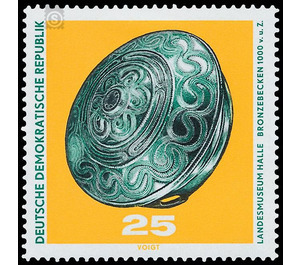Archaeological finds in the GDR - Germany / German Democratic Republic 1970 - 25 Pfennig
Theme: Post & Philately
| Country | Germany / German Democratic Republic |
| Issue Date | 1970 |
| Face Value | 25.00 |
| Color | yellow green |
| Perforation | K 13 |
| Printing Type | Photogravure |
| Stamp Type | Postage stamp |
| Item Type | Stamp |
| Chronological Issue Number | 1297 |
| Chronological Chapter | GER-DDR |
| SID | 953540 |
| In 12 Wishlists | |
Archaeological finds in the GDR The Ministry of Posts and Telecommunications of the German Democratic Republic issues four multi-colored special postage stamps with illustrations of archaeological finds in the GDR from the State Museum of Prehistory in Halle. Archaeological research in the German Democratic Republic has achieved many new and sometimes surprising results in recent years, which provide information about the life and activities of prehistoric man on the soil of the GDR. The GDR is one of the few states in the world in which the prehistoric and protohistorical landlords enjoy legal protection (Ordinance on the Protection and Preservation of Prehistoric and Early Historical Landscapes, 1954). One of the leading archaeological research centers in the GDR is the Landesmuseum für Vorgeschichte Halle (Saale), which enjoys a reputation far beyond the borders of our country and maintains international connections with similar research institutions on all continents. From the rich find of the Landesmuseum for prehistory Halle four objects were selected as motives for stamps, which are of special cultural-historical meaning. 25 Pfennig value bronze basin 1000 v. u. At the end of the Bronze Age, Ztr. Masterpieces of the craftsmanship of metal workers at the end of the Bronze Age are the thin-walled bowls with a curved bottom and two carrying eyes. These were made in a complicated casting process, which required a wealth of experience. Among ornamental patterns, which were hallmarked in perfect artistic manner, wave motifs prevailed. These ornaments are of such mathematical accuracy that it is believed that a complicated circular system was used to make them. There are not too many finds of this kind in the territory of the GDR. Apart from a few pieces in the northern Harz foothills, they have come to light especially in the Mecklenburg districts. Location of the suspension basin used as a motif: Schadeleben, Aschersleben district.


